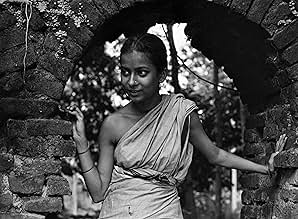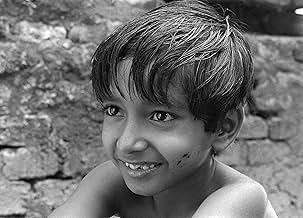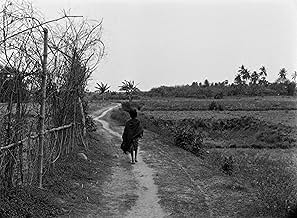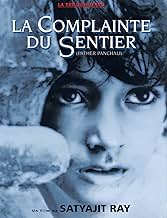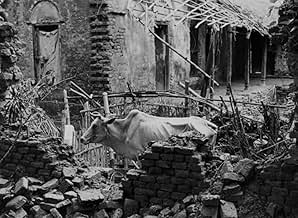CALIFICACIÓN DE IMDb
8.2/10
40 k
TU CALIFICACIÓN
Apu y su familia viven en la pobreza. Su padre Harihar sueña con una vida mejor para su familia y emprende un viaje fuera de su pueblo en Bengal para buscar trabajo. Pero en su ausencia ocur... Leer todoApu y su familia viven en la pobreza. Su padre Harihar sueña con una vida mejor para su familia y emprende un viaje fuera de su pueblo en Bengal para buscar trabajo. Pero en su ausencia ocurre una tragedia.Apu y su familia viven en la pobreza. Su padre Harihar sueña con una vida mejor para su familia y emprende un viaje fuera de su pueblo en Bengal para buscar trabajo. Pero en su ausencia ocurre una tragedia.
- Dirección
- Guionistas
- Elenco
- Nominada a1 premio BAFTA
- 11 premios ganados y 3 nominaciones en total
Kanu Bannerjee
- Harihar Ray
- (as Kanu Bandyopadhyay)
Karuna Bannerjee
- Sarbojaya Ray
- (as Karuna Bandopadhyay)
Subir Banerjee
- Apu Ray
- (as Subir Bandopadhyay)
Uma Das Gupta
- Durga
- (as Uma Dasgupta)
Runki Banerjee
- Little Durga
- (as Runki Bandopadhyay)
Haren Banerjee
- Chinibas, Sweet-seller
- (as Haren Bandyopadhyay)
Roma Ganguli
- Roma
- (as Rama Gangopadhyay)
Binoy Mukherjee
- Baidyanath Majumdar
- (as Binoy Mukhopadhyay)
- Dirección
- Guionistas
- Todo el elenco y el equipo
- Producción, taquilla y más en IMDbPro
Opiniones destacadas
I don't know how even 6.4% of the female voters could have given this movie a 2!!!!! This was Ray's first movie, but his economy of dialog, his synchronization and sympathy with India's rural life is incredible. So little said, yet so much! Apu and Durga following the sweetmeat seller, the scene where they run through a "kash" field....superb, the work of a real artist, a master. The film develops its characters and the atmosphere slowly and resolutely. The narrative builds up to a powerful climax. Ray had an ancient camera while shooting this movie, did it matter? No. His expression and technique was more than sound, although this was a maiden venture.
Some critics found(and still find, I might add) the film to be too slow. Satyajit Ray wrote about the slow pace - "The cinematic material dictated a style to me, a very slow rhythm determined by nature, the landscape, the country. The script had to retain some of the rambling quality of the novel because that in itself contained a clue to the authenticity: life in a poor Bengali village does ramble."
There you are, if you have not watched this movie, you'll probably missed the greatest movie made on Indian rural life. That's why Akira Kurosawa said of him:"To have not seen the films of Ray is to have lived in the world without ever having seen the moon and the sun"
Some critics found(and still find, I might add) the film to be too slow. Satyajit Ray wrote about the slow pace - "The cinematic material dictated a style to me, a very slow rhythm determined by nature, the landscape, the country. The script had to retain some of the rambling quality of the novel because that in itself contained a clue to the authenticity: life in a poor Bengali village does ramble."
There you are, if you have not watched this movie, you'll probably missed the greatest movie made on Indian rural life. That's why Akira Kurosawa said of him:"To have not seen the films of Ray is to have lived in the world without ever having seen the moon and the sun"
10ballweg
I originally saw the Apu trilogy in 1961 in a little theater in Berkley. Sat through a straight showing of all three films and walked out after six hours in awe. It was a defining day in the development of an avid film buff. I have waited three years for the DVDs to be released, and hoped against hope that Criterion would get the rights, but it was not to be. Sony has released an unadorned, Mirchant and Ivory Foundation restoration: but they are finally available. I bought all three of the Trilogy the day they were released, but have been reluctant to put them on. So many of my memories of "great" films have made me wonder what I was on when I saw it to think that was great. Think "Brewster McCloud." My experience of Pather Panchali and the full trilogy was a memory I didn't want diminished in any way. Tonight I came home from work, put the Pather Panchali in and sat totally rapt for the full two hours. The DVD production values and the print quality are really bad in spots, but all that fades as one of the really great art films takes over, and the immersion in the lives behind the film works its magic. Film doesn't have to be an act of corporate commerce: Pather Panchali is living proof that film can be a medium of great art.
What a wonderful film. For those who have not watched any films from India or heard of Ray, I strongly recommend it. Full of sadness, hope, innocence, and despair, it is an emotionally evocative portrait of the life of an Indian family, their trials, and their courage and persistence throughout. They go on, not because they are exceptional, but because they must, because they are human.
Ray does a masterful job of capturing the simple joys of childhood, and the ambitions and dreams which make us all human, regardless of where we are. Simple scenes such as a disfigured elderly woman seated on a porch, singing of her approaching death, are very moving. I have never seen the basic elements of life treated with such an incisive yet soft touch as Ray has in this film. It is wonderful to watch in comparison to the broad writing strokes and vulgar generalities of most directing and writing today. At the risk of sounding trite, this is a film which is not merely entertainment or art, but one which reaches into your heart and makes a place for itself there. It belongs there.
Ray does a masterful job of capturing the simple joys of childhood, and the ambitions and dreams which make us all human, regardless of where we are. Simple scenes such as a disfigured elderly woman seated on a porch, singing of her approaching death, are very moving. I have never seen the basic elements of life treated with such an incisive yet soft touch as Ray has in this film. It is wonderful to watch in comparison to the broad writing strokes and vulgar generalities of most directing and writing today. At the risk of sounding trite, this is a film which is not merely entertainment or art, but one which reaches into your heart and makes a place for itself there. It belongs there.
10sumanta6
The film is certainly a masterpiece. The film is overwhelmingly real and the key element in the movie is the maintenance of this realism. The characters are so true to the ethnic rural-sixties Indian existence that one is compelled to wonder if the film was captured through surveillance cameras.
Pather Panchali, released in 1955, is the first film of director Satyajit Ray's Apu trilogy. The film is a serene and beautiful depiction of a little boy's childhood in the Indian countryside in the 1950s.The film was made on a shoestring budget by a hitherto unknown director. Apart from a seventy-year-old woman who made her name in the 1930s on the stage, none of the cast had ever acted before and many had been plucked from the Indian rurality. In contrast Satyajit Ray completed the trilogy on the behest of the Indian Prime Minister, pointing to the film's cultural impact.
It's a quiet, simple tale, centering on the life of a small family living in a rural village in Bengal. The father, Harihar (Kanu Bannerjee), is a priest and poet who cares more about his writing and spiritual welfare than obtaining wages he is owed. The mother, Sarbojaya (Karuna Bannerjee), worries that her husband's financial laxity will leave her without enough food for her two children, daughter Durga (Uma Das Gupta) and son Apu (Subir Bannerjee). Harihar's family often lives on the edge of poverty, coping with the unkind taunts of their neighbors, the burden of caring for an aging aunt (Chunibala Devi), and the terrible aftermath of a natural catastrophe.
Most of what transpires is shown through the eyes of either Sarbojaya or Durga, and, as a result, we identify most closely with these two. Harihar is absent for more than half of the movie, and, before the penultimate scene, Apu is a mere witness to events, rather than a participant. Until the closing moments, we don't get a sense of the young boy as a fully formed individual, since he's always in someone else's shadow.
The simple story of the Bengali family will definitely stay in my heart for a long time to come. If you haven't seen it yet, what are you waiting for?........
Pather Panchali, released in 1955, is the first film of director Satyajit Ray's Apu trilogy. The film is a serene and beautiful depiction of a little boy's childhood in the Indian countryside in the 1950s.The film was made on a shoestring budget by a hitherto unknown director. Apart from a seventy-year-old woman who made her name in the 1930s on the stage, none of the cast had ever acted before and many had been plucked from the Indian rurality. In contrast Satyajit Ray completed the trilogy on the behest of the Indian Prime Minister, pointing to the film's cultural impact.
It's a quiet, simple tale, centering on the life of a small family living in a rural village in Bengal. The father, Harihar (Kanu Bannerjee), is a priest and poet who cares more about his writing and spiritual welfare than obtaining wages he is owed. The mother, Sarbojaya (Karuna Bannerjee), worries that her husband's financial laxity will leave her without enough food for her two children, daughter Durga (Uma Das Gupta) and son Apu (Subir Bannerjee). Harihar's family often lives on the edge of poverty, coping with the unkind taunts of their neighbors, the burden of caring for an aging aunt (Chunibala Devi), and the terrible aftermath of a natural catastrophe.
Most of what transpires is shown through the eyes of either Sarbojaya or Durga, and, as a result, we identify most closely with these two. Harihar is absent for more than half of the movie, and, before the penultimate scene, Apu is a mere witness to events, rather than a participant. Until the closing moments, we don't get a sense of the young boy as a fully formed individual, since he's always in someone else's shadow.
The simple story of the Bengali family will definitely stay in my heart for a long time to come. If you haven't seen it yet, what are you waiting for?........
There is this one scene in Satyajit Ray's Pather Panchali when the eruption of a conflict between Apu's family and a quarrelsome neighbour brought the film to a complete standstill (for me anyway). Those few characters' state of mind and their relationship dynamics at that point in time, was conveyed with such explosive intensity, I got gut punched drunk.
Pather Panchali boasts of suitably melodramatic yet highly intuitive performances. Its breath taking cinematography ranks alongside existential beauty this side of Malick heaven. The musical scoring, by the great Ravi Shankar, is identifiably Indian, yet universally sublime. Together, these myriad parts melded into a whole so grand in its social consciousness, so incisively intimate in its portrait of one family, I could do nothing but be slowly devoured like a most willing prey.
On 4th Oct 2003, I saw my all time favourite film, Tokyo Story. The feeling I got today from Pather Panchali, is as close as is possible from that fateful October day.
Pather Panchali is one of the best films I have ever seen. This will be a night to remember. Now on with the other two then.
Pather Panchali boasts of suitably melodramatic yet highly intuitive performances. Its breath taking cinematography ranks alongside existential beauty this side of Malick heaven. The musical scoring, by the great Ravi Shankar, is identifiably Indian, yet universally sublime. Together, these myriad parts melded into a whole so grand in its social consciousness, so incisively intimate in its portrait of one family, I could do nothing but be slowly devoured like a most willing prey.
On 4th Oct 2003, I saw my all time favourite film, Tokyo Story. The feeling I got today from Pather Panchali, is as close as is possible from that fateful October day.
Pather Panchali is one of the best films I have ever seen. This will be a night to remember. Now on with the other two then.
¿Sabías que…?
- TriviaHalfway through filming, Ray ran out of funds. The Government of West Bengal loaned him the rest, allowing him to complete the film. This loan is listed in public records at the time as "roads improvement", a nod to the film's translated title.
- ErroresAlthough the film is set in early 20th-century rural India (a time in which public health campaigns presumably did not exist), when Apu and Durga are shown hiding in the fields waiting to catch a glimpse of the train, a vaccination mark is clearly visible on the right arm of Uma Das Gupta, who portrays Durga.
- Versiones alternativasThere is an Italian edition of this film on DVD, re-edited with the contribution of film historian Riccardo Cusin. This version is also available for streaming on some platforms.
- ConexionesFeatured in Century of Cinema: And the Show Goes On: Indian Chapter (1996)
Selecciones populares
Inicia sesión para calificar y agrega a la lista de videos para obtener recomendaciones personalizadas
- How long is Pather Panchali?Con tecnología de Alexa
Detalles
- Fecha de lanzamiento
- País de origen
- Sitio oficial
- Idioma
- También se conoce como
- Pather Panchali
- Locaciones de filmación
- Boral, West Bengal, India(entire movie)
- Productora
- Ver más créditos de la compañía en IMDbPro
Taquilla
- Total en EE. UU. y Canadá
- USD 134,241
- Fin de semana de estreno en EE. UU. y Canadá
- USD 16,064
- 10 may 2015
- Total a nivel mundial
- USD 135,342
- Tiempo de ejecución2 horas 5 minutos
- Color
- Relación de aspecto
- 1.37 : 1
Contribuir a esta página
Sugiere una edición o agrega el contenido que falta

Principales brechas de datos
What was the official certification given to La canción del camino (1955) in Mexico?
Responda

